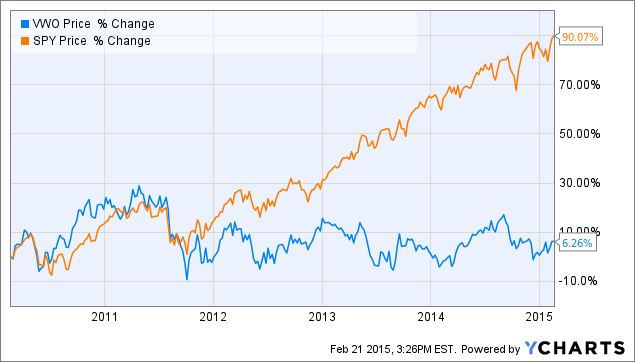VWO is Vanguard’s flagship emerging markets exchange traded fund. The fund trades like a normal stock and can be bought and sold at most brokerages. VWO is one of the best ways to get exposure to rapidly growing emerging markets like China, Brazil, and South Africa, among others. This is obviously a riskier basket of nations, which is why the ETF is a perfect investment for the youthful investor.
Through most brokerages, it is not possible to buy international stocks directly, and some countries, such as China, even limit the purchase of equities by foreigners. In addition, emerging market stocks hold extra risk due to their generally more lax regulatory environments as well as low levels of infrastructure. VWO helps mitigate these risks by bundling together over 3000 of the top emerging market stocks, which helps diversify away the risk associated with individual holdings.
Why take on the extra market risk of emerging markets, though? With China and Brazil consistently in the news in the last few weeks due to their mass of economic problems, some investors are afraid to enter such markets. This is where the youthful investor’s largest advantage comes into play: time. According to Christopher Brightman, chief investment officer at Research Affiliates, the Shiller price-to-earnings ratio, a cyclically adjusted version of the standard P/E ratio, fell to below 10 for emerging market equities recently. This has only happened ten times in the last 25 years, and in the following five years, the average gain on those equities was 188%. With emerging market stocks at one of their cheapest points in recent memory after a more than three year bear market, young investors should be diving in to take a contrarian position by means of averaging into a solid position in VWO. Even if the bear market continues for several months or years, the strong long run growth of many of these economies will ultimately provide outsized returns compared to tamer markets such as the U.S. just by nature of the fact that they each have a massive population and a GDP per capita that is well below those of first world nations. These countries will eventually develop, as we have already started to see in cities and factory regions of China and Brazil, and will only continue to do so over time. Capturing this growth will lead to a great return in the longer run, it just requires patience and the ability to weather high levels of volatility.

Another aspect that scares many investors away from emerging markets is the high cost of investing. Many emerging market funds have an expense ratio of 1% or more, which can really cut into your capital over time and hinder growth. VWO, however, clocks in at just a 0.15% annual fee. While still not as good as some S&P index funds that have expenses of 0.05% or less, it’s definitely a workable fee considering the potential for growth of the asset.
Lastly, VWO’s dividend is solid to say the least. Currently, it’s about 3.4% annually. This gives the investor a great cushion in case the fund continues to decline for another couple of years, and will deliver passible returns if the fund stagnates while Brazil and China work on transitions in their economy.
Ultimately, with its low expense ratio, high dividend, and exposure to an asset class that will outperform in the long run, VWO should be one of the youthful investor’s top holdings, and an ETF that he or she adds additional capital to regularly.
To learn more about VWO, visit Vanguard’s fund summary.